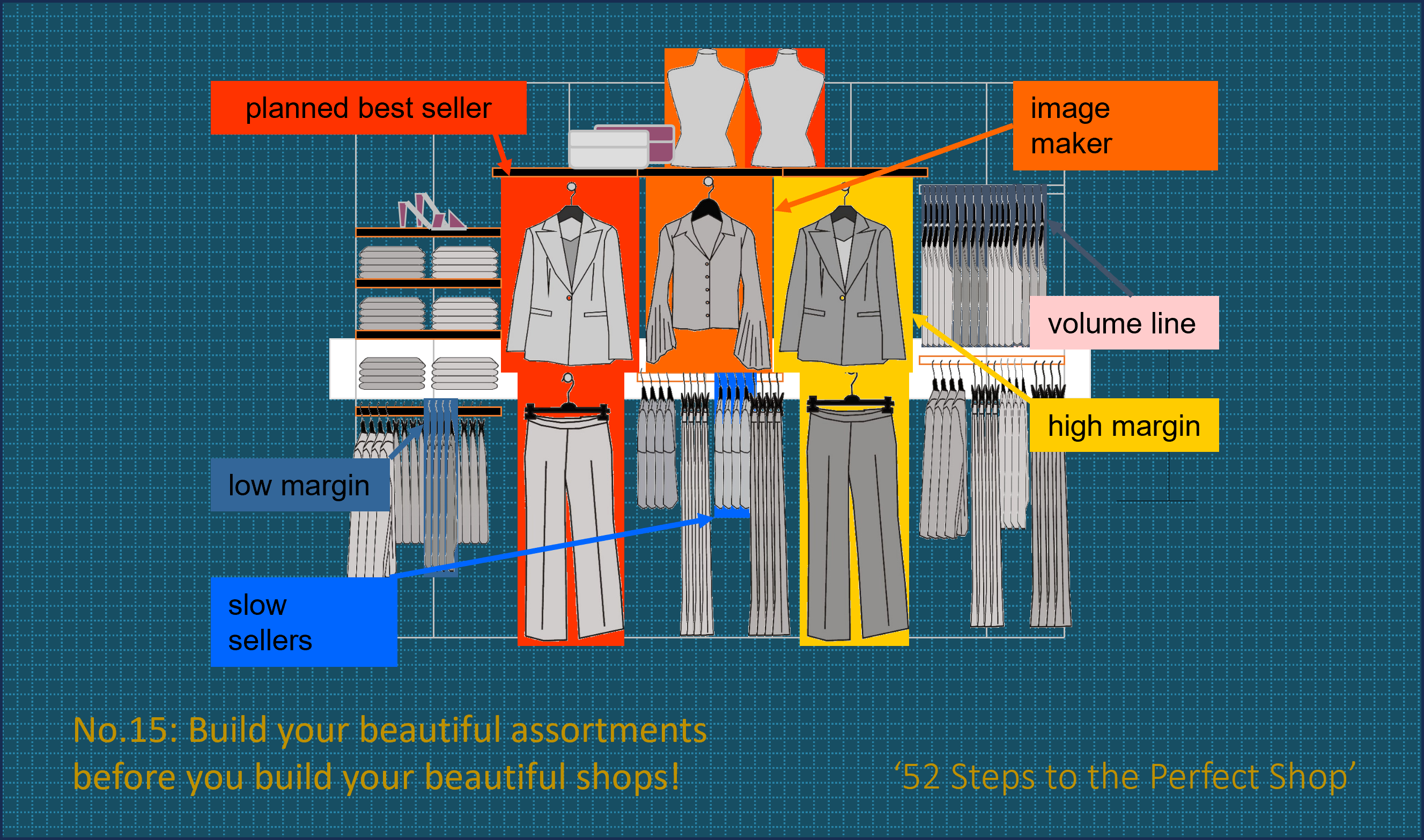Post No.15 in the weekly newsletter series:
‘52 Steps to the Perfect Shop!’
You too can have ‘The Perfect Shop’ by this time next year!
It may surprise some followers and readers that we have made it to step no. 15 in the ’52 Steps to the Perfect Shop!’ without having discussed designing shops, store layouts, fixtures, graphics etc.
We have spent the first part of the series very much discussing the importance of product stories, and different types of products from categories that give us authority, through themes and silhouettes that provide dynamic inspiration and then to our hero products that drive commercial sales and form the customer perception of a brand.
The reason for the sequence is to avoid one of the most common and critical mistakes when designing a shop. The mistake is to jump into a creative shop concept without considering the product that will go into it.
I’ve seen so many cases of architects taking the lead, seducing retail directors with vivid colour palettes, luxurious materials and mood boards, examples of Wow! Digital screens, and sumptuous fabrics for fitting rooms and service areas.
Important indeed, but what happens next? When the design fortune has been spent and the retail buyers, merchandisers, store operations and managers try to fit the assortment into this creative space, it simply cannot be done.
It won’t fit, the ranges can’t be displayed together, the fixtures aren’t appropriate for the types of product, and we simply get all the wrong products in the wrong places. The shop is a visual and commercial disaster!
It is a case of ‘The Emperors New Shop!’ Avoid it at all costs. And believe me, it will cost.
The ‘Emperor’s New Clothes’ is a famous children’s story, but I find it useful to illustrate what can often happen when retailers decide to embark on a new ‘Shop of the Future!’
In the ‘Emperor’s New Clothes,’ an emperor is looking for the most beautiful outfit ever. Some scandalous fashion designers dress the emperor in their meticulously designed garments. However to him and his advisers, there appear to be no clothes on the emperor. He’s is naked.
But the willey designers say that the clothes can only be seen by the wisest and most discerning of people. And so the proud and vain emperor, then his advisers all agree that they can see the marvelous new clothes.
It is only on the parade that a small buy points out the obvious, that the emperor is of course naked. The emperor quickly becomes a laughing-stock, but by this time the designers have disappeared with their fortunes.
This may be a cynical or widely accurate view of retail interior designers, but it happens. Ultimately the customer will call you out if you spend all your budget on an impressive but useless and inappropriate shop design, and you ignore your assortment.
Worse that that, the customers will not frequent your stores, no matter how beautiful, ever again.
The customers, like the small boy, appreciate nice shops but what they will see and react to over and over again is the beautiful assortment that is in your shops.
So, this is why we focus first on our assortment. But not an assortment in isolation from shops, but an assortment that will work both quantitively and qualitatively in all of your shops.
The product will fit, the product blocks will be clear and powerful, and the beautiful products will be visible and attractive to the customer.
This is why we don’t talk about individual isolated products. We talk about product stories, we talk about product blocks, we talk about category blocks, theme blocks and hero product blocks. And most of all we talk about ‘buying for space!’
Every product buying decision is made considering how it will look in a physical shop.
To create your perfect shop you must firstly build your perfect product assortment, and then you must build your beautiful shop to accommodate and show off your assortment.
This product planning process can often be tedious. We need to look at numbers before we look at style and fashion. And then we need to do calculations of square metres, linear metres and space conversions before we look at wood, at glass and marble fittings.
It also requires that people and departments without creativity need to begin the process and remain at its core. This goes against the logic of allocating shop design and concepts to the creative teams within a business.
But as we have seen, all departments need to be involved in the building of assortments, and the very same diverse teams need to be involved in the building of stores.
The process is not a relay with the passing of batons between teams, but a complex ‘3-legged race’ from beginning to end, where everyone needs to work together, to integrate and cooperate, to get over the finish line, and win.
So, build your assortments before you build your shops, and always do it together.
For everyone looking to improve their physical shops, or thinking of opening their first pop-up or permanent shop.
The weekly newsletters, and the 10 content modules they feature, have been created from my experiences of opening hundreds of shops, of all different sizes, situated across the world, selling just about everything there is to sell.
Every week we explore the sequential process of physical shop development to help you deliver your perfect shop.
Missed any of the previous ’52 Steps’ then just click here to catch up…
